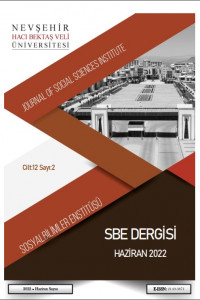Abstract
Bu makalede, çevrimiçi film incelemelerinin türü, Sistemik İşlevsel Dilbilim (SFL) yaklaşımı ve kesit analizi ile incelenmiştir. Daha önceki derlem analizleri, bu türün belirli aşamaları olduğunu göstermiştir. Aşamalar, zorunlu bir Değerlendirme aşaması ile birlikte Konu, Tema, Karakterler, Arka Plan olarak belirlenir. Her aşama, özellikleri ile tanımlanmış ve metinlerde nasıl gerçekleştiği örneklenmiştir. Ana aşamaların sözcüksel ve dilbilgisel özellikleri açıklanmıştır. Sözcüksel-dilbilgisel özelliklerin yanı sıra retorik özellikler ve kesit analizi de belirtilmiştir. Analiz sonuçları, Türk eleştirmenleri tarafından yazılan çevrimiçi film eleştirilerinin de bu türdeki makro yapıları takip ettiğini, sözcüksel ve dilbilgisel özelliklerin tanıtım türüne uygun bir tutum sergilediğini göstermiştir. Arka plan, Konu ve Değerlendirme aşamaları, uluslararası literatürde belirtilen önceki çalışmalardan farklı olarak Türkçe incelemelerde üç zorunlu aşama olarak bulunmuştur. Türk eleştirmenler tarafından oluşturulan film incelemeleri, bir Değerlendirme aşaması ile değil, arka plan veya Konu aşaması ile belirgin bir şekilde başlatılmaktadır.
References
- Almurashi, W. A. (2016). An introduction to Halliday’s systemic functional linguistics. Journal for the study of English Linguistics, 4(1), 70-80.
- Bhatia, Vijay, K. 1993. Analysing Genre: Language Use in Proffessional Settings.Longman, London.22
- Chen, Y., Xie, J., 2008. Online consumer review: word of mouth as a new element of marketing communication mix. Management Science 54 (3), 477–491.
- De Groot, E.B., Korzilius, H., Nickerson, C., Gerritsen, M., 2006. A corpus analysis of text themes and photographic themes in managerial forewords of DutchEnglish and British annual general reports. IEEE Transactions on Professional Communication 49 (3), 217–235.
- De Jong, I. K., & Burgers, C. (2013). Do consumer critics write differently from professional critics? A genre analysis of online film reviews. Discourse, Context & Media, 2(2), 75-83.
- Dirgeyasa, I. W. (2016). Genre-Based Approach: What and How to Teach and to Learn Writing. English Language Teaching, 9(9), 45-51.
- Holbrook, M.B., 1999. Popular appeal versus expert judgments of motion pictures. Journal of Consumer Research 26 (2), 144–155.
- Hsu, Greta & Joel M. Podolny. 2004. Critiquing the critics: An approach for the comparative evaluation of critical schemas. Social Science Research 34. 189–214.
- Leggett, B. J. 2005. Convergence and divergence in the movie review: Bonnie and Clyde. Film Criticism 30(2). 1- 23.
- Na, J. C., Thet, T. T., & Khoo, C. S. (2010). Comparing sentiment expression in movie reviews from four online genres. Online Information Review.
- Schleppegrell, M. (2004). The language of schooling: A functional linguistics perspective. Erlbaum, Mahwah
- Swales, J. 1990. Genre Analysis: English in Academic and Research Settings. Cambridge: CUP.
- Upton, T., Cohen, M.A., 2009. An approach to corpus-based discourse analysis: the move analysis as example. Discourse Studies 11 (5), 585–605.
- Taboada, M. (2011). Stages in an online review genre. Text & Talk, 31(2), 247-269.
Abstract
References
- Almurashi, W. A. (2016). An introduction to Halliday’s systemic functional linguistics. Journal for the study of English Linguistics, 4(1), 70-80.
- Bhatia, Vijay, K. 1993. Analysing Genre: Language Use in Proffessional Settings.Longman, London.22
- Chen, Y., Xie, J., 2008. Online consumer review: word of mouth as a new element of marketing communication mix. Management Science 54 (3), 477–491.
- De Groot, E.B., Korzilius, H., Nickerson, C., Gerritsen, M., 2006. A corpus analysis of text themes and photographic themes in managerial forewords of DutchEnglish and British annual general reports. IEEE Transactions on Professional Communication 49 (3), 217–235.
- De Jong, I. K., & Burgers, C. (2013). Do consumer critics write differently from professional critics? A genre analysis of online film reviews. Discourse, Context & Media, 2(2), 75-83.
- Dirgeyasa, I. W. (2016). Genre-Based Approach: What and How to Teach and to Learn Writing. English Language Teaching, 9(9), 45-51.
- Holbrook, M.B., 1999. Popular appeal versus expert judgments of motion pictures. Journal of Consumer Research 26 (2), 144–155.
- Hsu, Greta & Joel M. Podolny. 2004. Critiquing the critics: An approach for the comparative evaluation of critical schemas. Social Science Research 34. 189–214.
- Leggett, B. J. 2005. Convergence and divergence in the movie review: Bonnie and Clyde. Film Criticism 30(2). 1- 23.
- Na, J. C., Thet, T. T., & Khoo, C. S. (2010). Comparing sentiment expression in movie reviews from four online genres. Online Information Review.
- Schleppegrell, M. (2004). The language of schooling: A functional linguistics perspective. Erlbaum, Mahwah
- Swales, J. 1990. Genre Analysis: English in Academic and Research Settings. Cambridge: CUP.
- Upton, T., Cohen, M.A., 2009. An approach to corpus-based discourse analysis: the move analysis as example. Discourse Studies 11 (5), 585–605.
- Taboada, M. (2011). Stages in an online review genre. Text & Talk, 31(2), 247-269.
Details
| Primary Language | English |
|---|---|
| Journal Section | DİLBİLİM |
| Authors | |
| Early Pub Date | June 30, 2022 |
| Publication Date | July 15, 2022 |
| Published in Issue | Year 2022 Volume: 12 Issue: 2 |

